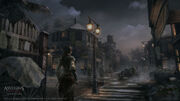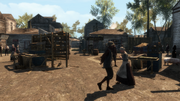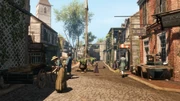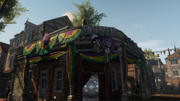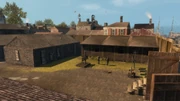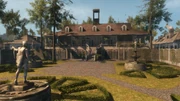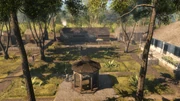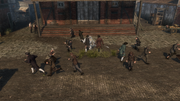New Orleans (French: La Nouvelle-Orléans) is a city located in southeastern Louisiana, straddling the Mississippi River.
History
French roots
Before French explorers and traders arrived in the 1690s, indigenous populations inhabited the grounds upon which New Orleans would be built; the city was founded on May 7, 1718 by the Company of the West. Slavery was prevalent even in the city's early days, being a significant component of New Orleans' complex and diversified society.[1]
Due to it being part of a critical trade route that linked the Mississippi River with the Gulf of Mexico, New Orleans quickly grew to become a major economic, political, and cultural center. Both the Assassins and the Templars soon realized the region's importance and subsequently established guilds there. The latter group would become involved in trade to secure their hold on the territory, as well as plot with local government officials.[1]
Spanish rule
Transition
- " I will do all I can to smooth the hand-over of the colony. And your mission will have all the workers it needs – provided you make good on your promise. Labor is in tight supply as it is, and, I must remain in power as gouverneur."
- ―D'Abbadie to de Ferrer, 1765.[src]
After France's defeat in the Seven Years' War in North America, New Orleans, along with the rest of Louisiana, was ceded to Spain in the Treaty of Fontainebleau in 1762, though the general populace remained unaware of this.[1] In 1763, Jean-Jacques Blaise d'Abbadie, the newly-appointed governor of Louisiana, was sent to the territory to dismantle the remaining French garrison and prepare the hand-over of the colony to Templar plants in the Spanish government.[2]
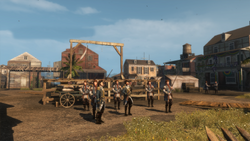
French troops stationed in New Orleans despite Spanish occupation
Roughly a year later, Spain's acquisition of Louisiana was officially announced. The Templar Order used the colony's transfer to gain access to the highest levels of government and extend their operations. Meanwhile, the transition from French colonial control to Spanish occupation left the residents of New Orleans dissatisfied with Spain's weak political authority, as it tried to distance itself from the previous French administrative structures.[1]
This ambiguous and unstable political environment soon enticed the Templars into attempting to take control of New Orleans.[1] In 1765, governor d'Abbadie made a deal with the Templar Rafael Joaquín de Ferrer; d'Abbadie would remain in power as governor, provided he supervised the colony's transfer and supplied de Ferrer with workers for a secret project. However, this scheme was uncovered by the Assassin Aveline de Grandpré, who assassinated the governor during a party held at his mansion.[2]
In 1766, the nobility of New Orleans was targeted by a dissident Assassin from Saint-Domingue named Baptiste, who intended to poison them to help the Templars tighten their grip on the city. This crisis was averted when Baptiste was assassinated by Aveline, putting an end to his plans for New Orleans.[2]
Louisiana Rebellion
- Main article: Louisiana Rebellion
- "How blessed we are with a daughter who uses her talents in peace... not to riot in the streets of New Orleans. There is so much unrest since the arrival of the Spanish..."
- ―Philippe Olivier de Grandpré on the consequences of the Spanish occupation, 1768.[src]
That same year, Antonio de Ulloa, a Templar adviser, arrived in New Orleans to serve as the Spanish governor of Louisiana. However, he allowed the French flag to remain over the city, leaving the administration of the territory to French Creole officials while he and his family lived at La Balize, away from New Orleans.[1] In secret, de Ulloa had citizens of low standing kidnapped, sending them to a work camp ran by de Ferrer in Chichen Itza, Mexico.[2]
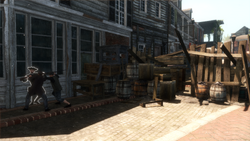
Citizens fighting de Ulloa's soldiers
In 1768, de Ulloa implemented rigid trade restrictions within the colony, which benefitted the Templars and allowed their shipment of workers to continue. This caused French Creoles' opinion of him to drop even lower and led them to rebel against the governor's regime. Riots soon grew commonplace, with citizens setting up barricades and openly challenging Spanish soldiers.[2]
The widespread chaos in the city eventually forced de Ulloa to leave his hiding place, so that he could attempt to negotiate for peace. While en route, his envoy was ambushed by Aveline, who had orders to assassinate the governor; however, she ultimately chose to spare him, and forced Ulloa to go into exile. Following his departure, New Orleans was briefly governed by the French creoles.[2]
Under the approval of the French King, the Spanish commissioned de Ulloa's replacement, General Alejandro O'Reilly to suppress the rebellion and punish those responsible. To prevent any further violence, French Creole leaders urged citizens to avoid military confrontation and accept Spanish authority. In the summer of 1769, O'Reilly arrived in New Orleans without any major interference and created the Laws of the Castille, which introduced a series of harsh reforms to punish the rebels.[1] In the following years, Spain secured a tighter grip on the colony, but also encouraged free trade and eased the restrictions on the emancipation of slaves.[2]
Elimination of the Templars
- "The Templars will never allow slaves to be free! They keep even the rich in bondage - though most people would never suspect..."
- ―Aveline on the Templars' control over New Orleans, 1768.[src]
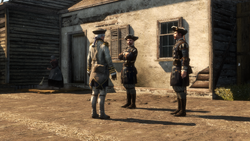
One of Vázquez's recruiters bribing Spanish soldiers
For a while, the city remained free of Templar machinations, but by 1771, a Templar by the name of Diego Vázquez became active in the region, recruiting Spanish soldiers to his cause through bribery. He intended to seize control of the Louisiana Bayou, which was economically important to New Orleans due to its popularity as a smuggling route. Vázquez's progress was temporarily set back by Aveline that same year, but her absence allowed his troops to recover.[2]
Preferring the British be kept away from Spanish territory, the Governor of Louisiana decided to support the American Patriots in 1776 by having the smugglers send them supplies, an arrangement that the Templars opposed. Vázquez subsequently ordered his men to steal the wares from the smugglers at the nearest opportunity, but in this too he failed, as Aveline would once more obstruct his schemes.[2]
Following the assassination of Vázquez that same year, the Templars' power in New Orleans dwindled, though the "Company Man" remained at large. In 1777, Louisiana's head Templar was revealed to be Madeleine de L'Isle, Aveline's stepmother. After being led to believe that Aveline would join the Templars, Madeleine was killed by her stepdaughter in the Saint Louis Cathedral, temporarily removing Templar influence in New Orleans.[2]
Louisiana Purchase
In the decades that followed, several devastating fires ravaged New Orleans, destroying much of the French colonial architecture. In 1801, Spanish rule ended and the city was handed back to the French, though Spain had made a considerable contribution to its expansion. However, French rule ended two years later when Napoleon Bonaparte sold the colony to the United States, a transaction directed by the United States President, Thomas Jefferson.[1]
Layout
New Orleans had a number of characteristic, scenic elements. As a prominent center for trade and commerce, the city was also a culturally diverse environment and full of life. Dotted with trees and lush gardens, the city's buildings were often constructed with angled roofs and decorative features such as balconies and gazebos. Marketplaces and courtyards were a common sight in New Orleans, and its streets were openly spaced with little traffic moving through them. A multifarious society, the general populace of New Orleans was varied, with a range of different people inhabiting the city.[2]
Founded as a French city, the colonists of New Orleans were usually of French origin and wore similar styles of clothing, often a mix between the wealthy and the poor. However, with a wide slave society, servants in New Orleans were a common sight, often dressed in civilized clothing similar to that of the colonists. Notable landmarks in New Orleans included Saint Louis Cathedral, the Place d'Armes, Saint Peter's Cemetery, Congo Square, Madame John's Legacy, the Governor's mansion, the de Grandpré mansion and the de Grandpré warehouse and Assassin headquarters.[2]
Trivia
- French soldiers were only found in New Orleans and the Louisiana Bayou during Sequences 1 and 2. In later sequences, they were replaced by Spanish guards, as Spain had, by then, started to assert its control over the colony.
Gallery
References
| ||||||||||||||||||||||||||||||||||



